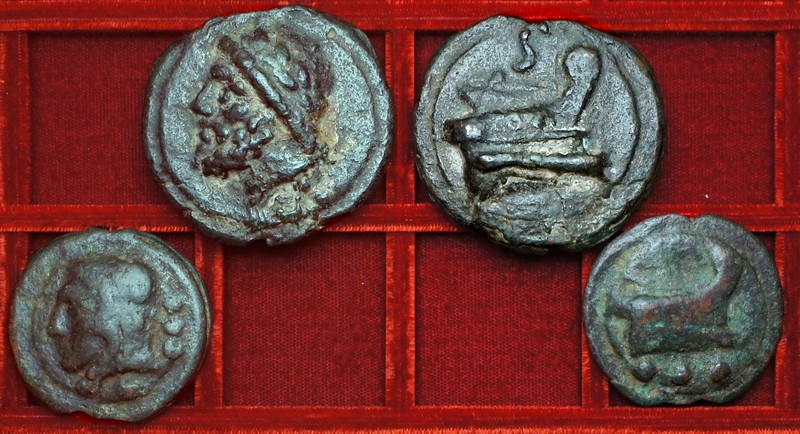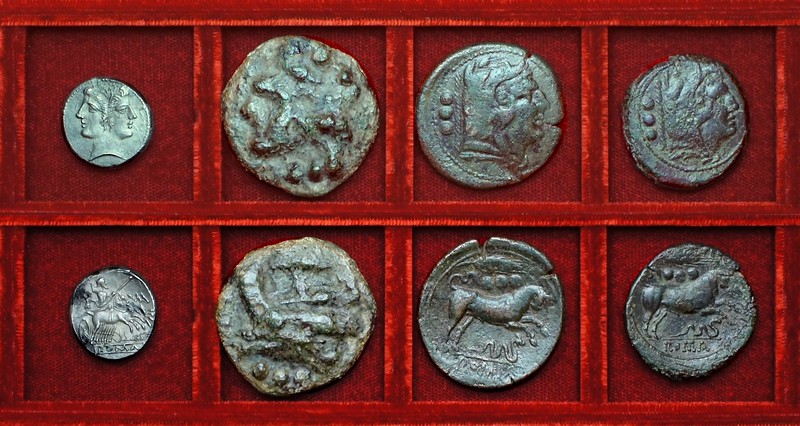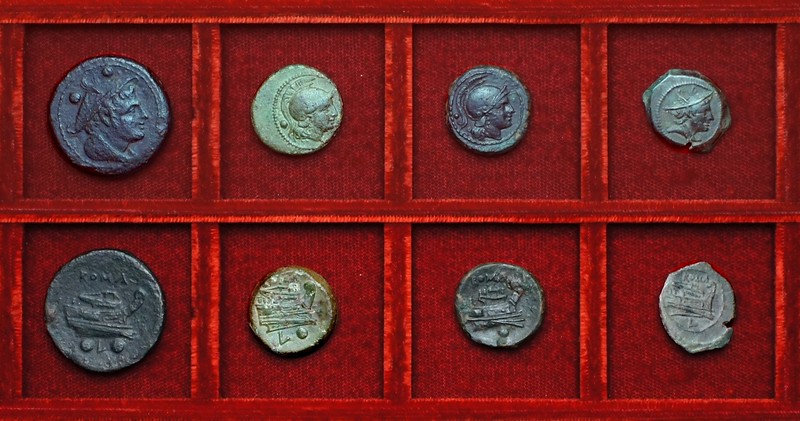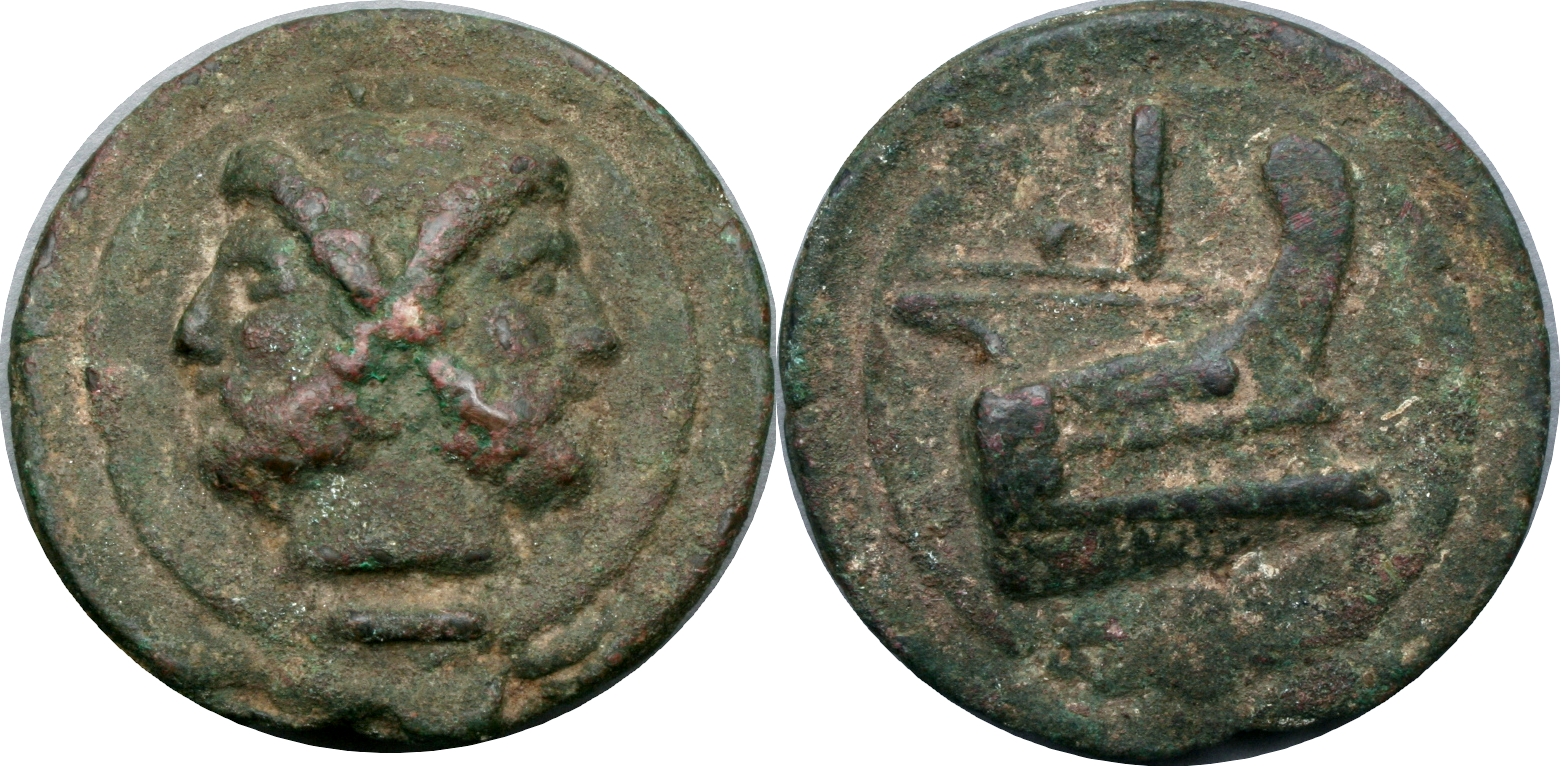Part 2: RRC 28 to RRC 43, 230BC to 213BC, Prow Aes Grave, Quadrigatus

|
Specialist Supplements:
1. Roman Coins of Luceria and Canusium
2. Anonymous Struck Bronze Coins of the Roman Republic
3. Anonymous Roman Republican Denarii and Victoriati (Steve Brinkman's site)
Principal Coins of the Roman Republic
Part 2: RRC 28 to RRC 43, 230BC to 213BC, Prow Aes Grave, Quadrigatus
RRC 28 Oath scene Janus stater.
RRC 28 oath scene gold half-stater modern reproduction. RRC 28 quadrigatus didrachm RRC 29 quadrigatus, RRC 31 dot quadrigatus. I present here a range of didrachms, whose commencement is dated by Crawford before the libral Prow aes grave types. That may or may not be true, but it's certain that the quadrigatus coinage continued well into the second Punic war, at a time when semilibral and perhaps post-semilibral bronzes were being made. So, some of these coins would be better distributed with RRC 38 and RRC 41, as in fact was done with the Sicilian quadrigatus type, RRC 42/1. This picture shows a range of probably early types, judging by their fine style. The first quadrigatus coin is of typical early RRC 28 style. The second quadrigatus, with relief legend on a raised tablet, a rarely seen feature in any coinage era, and of the finest style and superbly preserved, is RRC 29. The third quadrigatus, with Jupiter outside (behind) the chariot is RRC 31. The latter often show a dot in the truncation, and some early denarius coinage also show a dot. Pierluigi Debarnardi has suggested this is actually a mint-mark, and it also occurs on later denarii, quinarii and (rarely) sestertii and victoriati. The gold coin is a modern reproduction or forgery (dependent whether you consider it made with the intention to decorate or deceive) of an oath scene half stater. The Ahala collection will never have a genuine example of this rare type so this modern copy will suffice. The British Museum example of its double, the gold stater, is shown in the prior picture, which is a one-sided photograph as it was taken in the museum display case.
RRC 28 quadrigatusdidrcahm, a late-issue, RRC 30 quadrigatus didrachm, RRC 29 half-quadrigatus drachm, RRC 28 half-quadrigatus drachm. The two quadrigati are probably second Punic war issues, considering their degraded style and manufacture as compared with the previous picture. They may be of reduced quality silver. I show a much more debased quadrigatus alongside the semilibral coinage (at a later point on this page). The RRC 30 didrachm and the RRC 31 drachm appear stylistically linked by their obverse busts, but classify as RRC 30 (cf.RRC pl.VI,8) and RRC 29 (cf.RRC pl.V,11) respectively, surely indicative of the difficulty classifying quadrigati by any means other than a direct comparison with RRC plates. A die study is needed.
RRC 35 Prow Aes Grave As. Note this variant has a horizontal value mark under Janus' head, often missing from RRC 35 asses. Antonio Morello discusses the deck equipment on RRC 35 and later prow bronzes and concludes that the structure and line above the fighting platform represent a corvus, and dates the types earlier than Crawford's 225 BC, which is plausible considering the huge size of the issue and the lack of a cleat terminus ante-quem for its start. I summarise Morello's proposal on a web-page, The Roman boarding bridge on Prow Bronzes.
RRC 35 Prow Aes Grave semis, quadrans.
RRC 35 Prow Aes Grave triens, Minerva to left and right. The lower coin, with Minerva head to right, and lacking an obverse value mark, is important. It is of the very highest rarity, with just three specimens known by Haeberlin, and is of a different and finer style and lacks any obverse value mark.
RRC 35 Prow Aes Grave sextans, uncia, RRC 36 Prow-left Aes Grave quadrans, sextans. The RRC 36 prow left aes grave bronzes are a lot rarer than the RRC 35 prow-right types.
RRC 37 Minerva Bull Aes Grave As facing Minerva, Bull L, A portrait in cast bronze as expressive as Kimon, about 220 BC.
RRC 38 semilibral Aes Grave prow as, semis, RRC 28 debased quadrigatus didrachm late issue
RRC 38 semilibral sextans, semuncia, uncia and quartuncia. In Andrew McCabe's paper on anonymous struck prow bronzes, "The Anonymous Struck Bronze Coinage of the Roman Republic: a Provisional Arrangement" (2012) RRC 38 types are classified as group AA; later struck bronzes are categorised into groups from A (post-semilibral) to M (semuncial) and these letter groups will be referred to throughout these web-pages. A specialist webpage is dedicated to the Anonymous Struck Bronze Coinage of the Roman Republic.
RRC 39 Collateral Semilibral bronze series. These types remain a mystery to me. The designs and engraving are of the highest quality and interest, yet they seem out of place in the usual Roman Republican series.
RRC 40 corn-ear Aes Grave quadrans, Sicily RRC 41 Post-semilibral Aes Grave heavy 120g as, light 67 as and light 29g semis. The RRC 40 corn-ear quadrans is an enigmatic presumed-Sicilian issue that doesn't fit neatly with the usual aes grave coinage from northern Italy. The weight standard for the series is about semilibral. This example, though lighter than usual at 25.5 grams, matches other known pieces for size, style and design. The two cast asses have design devices that are about the same size yet the first coin is nearly double the weight of the second. The 120 gram specimen, weighing nearly 4.5 ounces, is close to semilibral in weight, exceeding the usual 4 ounce (108 gram) upper limit of coins considered post-semilibral. Still a coin from the same mould is used as a type example of RRC 41/5a in Thurlow Vecchi, pl.40,70, and the devices on this 120 gram coin are smaller than those on my above-illustrated RRC 38/1 although it weighs about the same (119 grams). So, I classify it as RRC 41/5a, and also the 67 gram coin beside it. I do not know what this means in terms of monetary history or fiscal logic. The cast semis of this series comes in every possible combination of head direction and prow direction.
RRC 41 post-semilibral Aes Grave dupondius. This was a very rare denomination and this example is hardly worn, perhaps kept as a souvenir.
RRC 41 post-semilibral bronzes. Michael Crawford classifies the pre-150 BC anonymous bronzes into three groups, RRC 41, RRC 56 and RRC 197-198A. These are broad divisions which reflect, respectively, coinage struck shortly after 215BC, coins from about 210BC onward, and coins struck in the mid first century BC. RRC 41 is generally recognisable by broad well-made flans, heavy weights and fine engraving. They weigh from 50 grams to 110 grams on an As-equivalent basis. I have proposed they be split into two major groups. The four coins here represent Group A1, which is heavier, has a triangular shaped box at keel level, often having waves within.
RRC 41 post-semilibral as, semis, triens and quadrans. These four coins of McCabe group A2 each have three converging lines with no waves at keel level, which contrasts with the triangular shaped box at keel level seen on the earlier group A1 coins. They are smaller and lighter than the group A1 coins. The RRC 41 struck As is of the type published by Roberto Russo in his article on unpublished bronze coins in Essays Hersh; it die matches other examples. It's on a relatively thin but very wide flan. The semis is struck over an RRC 38 semilibral prow sextans. The struck quadrans is a design variant, having a dot in place of the usual X marking the oar box.
RRC 42 corn-ear quadrigatus Sicily, RRC 40 corn-ear aes grave quadrans. RRC 42 corn-ear bull and snake quadrantes. The corn-ear quadrigatus used to be rare but examples are appearing from hoards; the issue remains rare in circulated condition. Charles Hersh did a die study in Essays Carson and Jenkins 1993, "A Sicilian Quadrigatus mint: the issue with the wheat-ear control mark". The quadrigatus has an unclear relation, if any, with the RRC 40 aes-grave corn-ear quadrans or with the RRC 42 bronzes. I show three corn-ear quadrantes above, RRC 40 and a large and small module RRC 42 bull and corn-ear. The RRC 42 and RRC 72 corn-ear bronzes are difficult to distinguish visually. RRC 42 is the earliest and heaviest type, likely quadrantal in weight, and including the iconic Bull and corn-ear type. The coins are frequently overstrikes. The bull and corn-ear Quadrans RRC 42/2 are commonly overstruck on Hieron II/Horseman bronzes of Syracuse (which date from 215BC or earlier) and more rarely over Ptolemy II. The Uncia RRC 42/4 is commonly overstruck on Hieron II Poseidon/Trident types and rarely over Carthagian bronzes. Crawford says that these coins were likely issued in connection with the arrival of Marcellus and the beginning of serious operationas against Syracuse in 214 BC. The Bull and corn-ear type comes directly from the pre-Denarius RRC39 collateral types, whose mint is presumed to be Rome. Why this sole type was taken for the Sicilian bronzes, and not the others, is unclear. The bull and cornear quadrans is oddly missing from Sydenham’s catalogue. Additionally Roberto Russo in Essays Hersh published a variant RRC 42 series, identical in all respects but missing the corn-ear, and including the Quadrans, Sextans, Uncia and Semuncia denominations; this anonymous type is classified as McCabe anonymous group B. I show two examples of the bull and corn-ear quadrans, of very similar weight - the coin at left weighs 14.88 grams, that at right 14.00 grams - yet clearly different modules. It is unclear whether the coin at right should belong to RRC 42 or RRC 72, or indeed whether the series can truly be distinguished.
RRC 42 corn-ear sextans, uncia, semuncia, Sicily.
RRC 43 L Luceria aes grave as and semis and struck bronze trientes. The cast As of Luceria is an extremely rare type. I have worked with Roberto Russo on an analysis of the struck bronzes of Luceria, to be published in 2013, which breaks the coinage into two major groups, one of Greek style and one of Italic style. I have published commentaries on the series on a separate web-page on the Roman coinage of Luceria.
The triens at the right is what I term an Italic style coin. Other Italic style coins form part of RRC 97 or RRC 98, hence this is the only example in RRC 43. The Italic style coins are struck on broad thin flans. Observe for example how much larger the Triens in this picture is as compared with the triens to its left, whilst being the same weight. Whilst artistically engraved, the obverse head of the triens is no beauty, and many of the Italic style coins on broad thin flans feature large eyes and very large noses. The mintmarks are invariably small, visible with difficulty or not at all under the head or chin. The stylistic oddities continue through later much lighter coins in RRC 97. This Italic group also features odd denominations and designs that include the Dextans or Ten Uncia coin, the Quincunx or 5 Uncia coin, which represent the Nummus and Half-Nummus in use in many Italian cities. The Quadrans with Mercury head is would easily be confused with a Roman sextans. The Dextans and Quincunx feature Ceres and either a Victory and Quadriga or the Dioscuri. The RRC 98 L-T coinage, probably from the same manufacture also features unusual types including a Minerva/Dioscuri Sextans. I have the impression of two separate mints, using different coining technology and engraving norms, one that initially produced coins for local civic use, based on a Dextans, with designs that involved horses, familiar in the Italian marketplace, whilst the other Greek style mint followed Roman norms for their struck bronze coins.
RRC 43 Luceria L struck semis, postsemilibral (42 grams), photographed with kind permission Dominique Hollard BNF Paris. This beautiful semis is what I term a Greek style coin. All have obverse engraving styles in the best Hellenistic tradition, the faces have a beauty and nobility to them, and features such as the petasus - winged hat - of Mercury, and the lion-skin of Hercules, are engraved in classical style. The coins are all struck on relatively thick and short flans. The mintmarks are all prominent and clear, whether behind the head, before the prow or in the prow exergue. This semis is possibly the finest struck prow bronze ever. The triens at the left of the above red tray, as well as all the coins in the next tray, are also of this Greek style.
RRC 43 L Luceria sextans, regular uncia, "5 mariners" uncia lacking mintmark, and semuncia. The four bronzes in this tray are what I term Greek style. The right-most uncia is also noteworthy, being unpublished. It has no mintmark but evidently belongs to Luceria, and the reverse prow is of a different design with five mariners on a deck which has different deck-top equipment to the left-hand uncia.
Specialist Supplements:
1. Roman Coins of Luceria and Canusium
2. Anonymous Struck Bronze Coins of the Roman Republic
3. Anonymous Roman Republican Denarii and Victoriati (Steve Brinkman's site)
All content copyright © 2004-2013 Andrew McCabe unless otherwise noted. If you've any questions or comments please contact me on the Yahoo Group RROME: http://groups.yahoo.com/group/RROME.
Alternately you can leave comments against any coin picture, just click on the picture and write in the comment box.
See my rarity estimates for Roman Republican Bronzes: Roman Republic Bronze Rarities..
Site hosted free courtesy of VCoins.com
Ancient Coins on Vcoins
comment: this page is RRC028.html. Update June 2013































